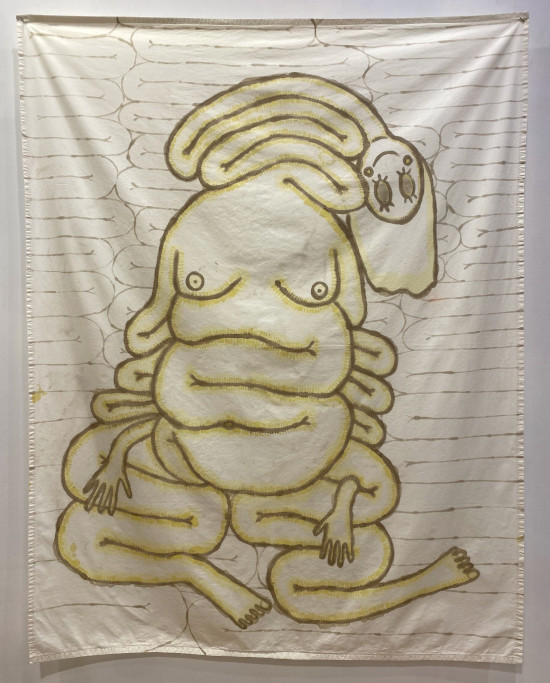The performance of wellness
Sick Party shows hidden disabilities in plain view

“Folds,” a mordant painting on felt by Katrina Craig, is part of her exhibition Sick Party. - Katrina Craig (Supplied)
Textile artist Katrina Craig knows how to throw a sick party.
Her exhibition Sick Party, on display at Arts AccessAbility Network Manitoba (AANM), is a series of figurative drawings that characterize the performative aspects of living publicly with disabilities.
“The performance of being well is often harder than the illness itself,” Craig says.
She lives with fibromyalgia and hyper-mobility, and her uncanny, tortured-look- ing figures personify her attempts to appear “normal” while hiding disability.
“I feel terrible, but I’m smiling, and act- ing like everything is fine,” she says.
AANM is a not-for-profit, artist-run organization with the main goal of improving accessibility in the arts for disabled artists and audiences. Craig is one of their members.
“Craig’s show (is) about the experience of being an artist with disabilities,” programs assistant Sacha Kopelow says, add- ing that their artists are not bound to that subject. “Her (work) is interesting, because it shows having a chronic illness that isn’t widely understood.”
Craig moved to Winnipeg in 2014 after graduating from the Nova Scotia College of Art and Design with a degree in textiles and fashion design. With a background that includes disability direct-support work, her art combines advocacy, community and her love for textiles.
“When I was really sick, I couldn’t do very much textile work,“ Craig says, “so I just started drawing these sort of weird, stretched-out, knotted, looped-like figures.”
Her drawings, made of natural dye, embroidery and mordant paintings on cotton, depict humanoid shapes with elongated limbs piling up or hanging loose like wet noodles.
“That is kind of what my body feels like sometimes, like it’s melting into a puddle because it’s not really holding itself up,” she says.
Kopelow says artists like Craig often mask their illnesses and make adjustments in order to produce their work.
“(They) sort of have to work around that disability in order to achieve a show,” she says.
To produce this exhibition, Craig had to move away from the meticulous and repetitive textile work that was typical of her pre-symptomatic days.
“Fibromyalgia has a lot of symptoms, but one of the major ones is widespread pain,” she says. Craig opted to work on cotton so as not to abandon her passion for textiles completely.
“It’s ergonomically a lot friendlier, and it’s not as much needlework,” she says of this process versus the painstaking amount
of embroidery she would normally use. AANM’s exhibitions promote inclusivity by offering online proxies with de- scriptive text, in-person ASL translation, wheelchair accessibility and loud or quiet viewing for those with tics or sensory sensitivities.
“There’s been steady movement forward with a few steps back each time, but I think we’re moving in the right direction,” Kopelow says.
Craig, who now calls Winnipeg home, agrees.
“There (are) some really great grassroots organizations here working on disability rights, but we still have a long way to go,” she says. “I think for people with physical disabilities, mental-health issues and intellectual disabilities, the world is still small.”
Sick Party runs through March 25 at AANM at 102-329 Cumberland Ave. and can be viewed online at bit.ly/3TxeKsn.
Published in Volume 78, Number 21 of The Uniter (March 14, 2024)







